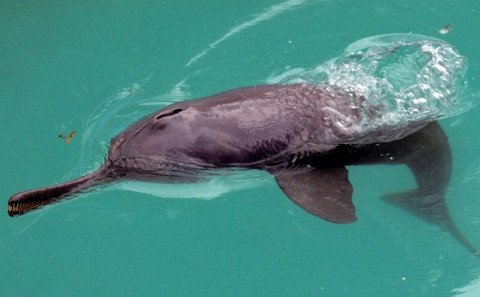Ganges river dolphin in India faces extinction
 0 Comment(s)
0 Comment(s) Print
Print E-mail China Dialogue, October 12, 2012
E-mail China Dialogue, October 12, 2012
 |
|
After the extinction of the Yangtze dolphin, the Ganges dolphin is one of only three freshwater dolphins left in the world. [Photo/China Dialogue] |
Why are dolphin numbers falling?
There are three main reasons why the Ganga (and the Indus) dolphins are in such danger. The most immediate cause is the use of nylon nets by fishermen. These freshwater dolphins are blind. They swim and find their prey through echolocation – they send out tiny sound waves, and the echoes tell their brain what is around. The nylon in the nets absorbs sound waves instead of reflecting them, explains Sandeep Behera, associate director of the River Basin and Biodiversity Programme in WWF-India; so the dolphin gets entangled in the net.
Dolphins are mammals and must come out of the water every five to seven minutes to breathe. An entangled dolphin cannot, and drowns. Fisheries departments of state governments along the Ganga basin prescribe traditional nets. But there is no ban on the far cheaper and more easily maintained nylon nets, and most fishermen use them.
That is the immediate cause. But there are two more fundamental causes. The first is reduced water flow. Rivers in the Ganga basin are the main suppliers of water to irrigation canals in the north Indian plains, and have been so for over 150 years. Dolphins prefer deep pools, which are shrinking all the time as more and more water is diverted. Plus, there are barrages to divert the water into the canals. The dolphins cannot cross them; and so populations get isolated and more vulnerable.
The second fundamental cause is pollution. Hundreds of factories and thousands of villages throw their untreated waste into the Ganga and its tributaries. At the top of the freshwater food chain, the dolphin accumulates all the harmful chemicals in its body, and often dies. The Yamuna – the largest tributary of the Ganga – turns into a stinking drain downstream of New Delhi, and has no dolphin until the Chambal River empties into the Yamuna over 250 kilometres downstream, giving it a new lease of life.






Go to Forum >>0 Comment(s)